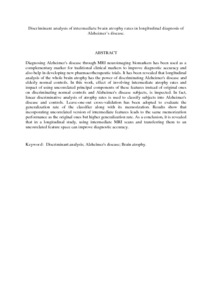Citation
Mashohor, Syamsiah and Ramli, Abdul Rahman and Mahmud, Rozi and Farzan, Ali
(2011)
Discriminant analysis of intermediate brain atrophy rates in longitudinal diagnosis of Alzheimer's disease.
Diagnostic Pathology, 6 (105).
pp. 1-9.
ISSN 1746-1596
Abstract
Diagnosing Alzheimer's disease through MRI neuroimaging biomarkers has been used as a complementary marker for traditional clinical markers to improve diagnostic accuracy and also help in developing new pharmacotherapeutic trials. It has been revealed that longitudinal analysis of the whole brain atrophy has the power of discriminating Alzheimer's disease and elderly normal controls. In this work, effect of involving intermediate atrophy rates and impact of using uncorrelated principal components of these features instead of original ones on discriminating normal controls and Alzheimer's disease subjects, is inspected. In fact, linear discriminative analysis of atrophy rates is used to classify subjects into Alzheimer's disease and controls. Leave-one-out cross-validation has been adopted to evaluate the generalization rate of the classifier along with its memorization. Results show that incorporating uncorrelated version of intermediate features leads to the same memorization performance as the original ones but higher generalization rate. As a conclusion, it is revealed that in a longitudinal study, using intermediate MRI scans and transferring them to an uncorrelated feature space can improve diagnostic accuracy.
Download File
![[img]](http://psasir.upm.edu.my/23207/1.hassmallThumbnailVersion/Discriminant%20analysis%20of%20intermediate%20brain%20atrophy%20rates%20in%20longitudinal%20diagnosis%20of%20Alzheimer.pdf)  Preview |
|
PDF (Abstract)
Discriminant analysis of intermediate brain atrophy rates in longitudinal diagnosis of Alzheimer.pdf
Download (83kB)
| Preview
|
|
Additional Metadata
Actions (login required)
 |
View Item |

